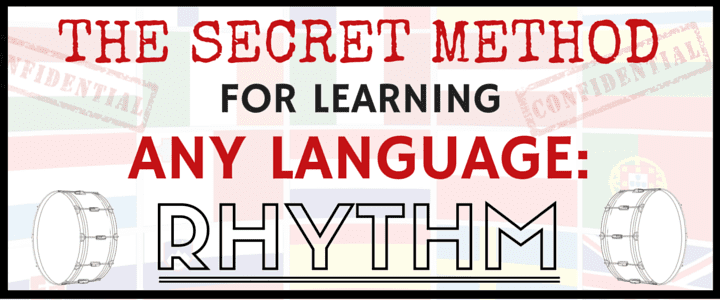Interested in learning a new language quickly? Want it to be fun? You’ve come to the right place! In this article, you’ll read about one of the best language learning methods for making any language easier to learn…
It takes a long time to learn a new language. You can spend over 250 hours studying a language and only reach minimum proficiency. Some of the more complex languages, like Japanese and Arabic, can require twice as much studying compared to, say Spanish or French.
Like learning any new skill or topic, mastering a language takes time, dedication, and plenty of practice. From memorizing vocabulary words to figuring out grammar rules, there is a wide range of areas you have to master before you can read, write, and speak in a new language.
But if you don’t have much time to learn a new language, you may be asking, “Where are the shortcuts? How can I learn quicker?” Just because you don’t have hours to dedicate to learning a new language doesn’t mean there aren’t tricks for picking up the language sooner. In fact, there are language learning methods that can make it easier for you to learn any language.
What Are Some Methods for Studying Language?
If you want to pick up a second language, you might want to try some of the following second language learning methods:
- Find a language you love and stick with it
- Label all of your household items in the language you’re trying to learn
- Read the news in your new language
- Set goals for yourself
- Use flashcards
- Make friends with a dictionary
- Play online language learning games
- Find a person you can practice speaking the language in
- Book a trip to the country you want to visit
- Practice your rhythm (more on this later in the article!)
Of course, the best method to learn a new language is to take language lessons with a skilled instructor. They’ll be able to help you figure out any missteps you’re making – and give you some ideas of techniques you can try on your own. The video below is a great example of everything that language lessons have to offer:
The Best Method to Learn a Language: Keeping Rhythm
Below, we discuss a specific learning method backed by science and data. It’s a technique that involves using rhythm to practice pronouncing syllables. This language learning method is easy to understand. And the good news? It’s fun!
Ready to learn the secret method on how to learn any language? Let’s jump right into it!
It’s simple: keep a steady beat. If you can’t quite keep a steady beat, don’t worry – you don’t have to be a drummer to learn this technique. In fact, you don’t need to know anything about rhythm at all; our brains automatically operate by rhythms all the time!
Being able to keep a beat is directly correlated to having a healthy brain. It helps to achieve and maintain focus, clarity, and creativity. You see, accurate beat-keeping activates hearing as well as movement. When your brain synchronizes the two, it creates neural pathways that lead to better cognitive development. Don’t believe us? Just watch.
Why is This Language Learning Method Useful?
You already speak in rhythms. Just for fun, recite this sentence aloud: “Who told you about my cat?” Those seven syllables are spoken with a very distinct rhythm. Did you think about it much? No – that’s because you already learned the rhythm associated with speaking English.
By learning how a language’s syllables are spoken, you’ll be able to recognize speech patterns much easier. Processing new information about your desired language will be simpler once you recognize patterns. This applies to reading and writing just as much as speaking.
Why is This the Best Language Learning Method?
This language learning method isn’t just a bunch of nonsense; it’s supported by countless hours of scientific research. One study in particular outlines exactly what we’re trying to explain.
In 2013, the director of Northwestern University’s Auditory Neuroscience Laboratory, Nina Kraus, conducted an experiment to further explore the link between rhythmic abilities and language skills. She published an academic paper with her findings, alongside co-author Adam Tierney.
Here’s an overview of Nina’s experiment:
To investigate the relationship between beat-keeping and auditory processing, 124 Chicago high school students visited Kraus’ lab and were given two tests. In the first, they were asked to listen to a metronome and tap their finger along to it on a special tapping pad. Tapping accuracy was computed based on how closely their taps aligned in time to the tick-tock of the metronome.
– Wendy Leopold, The Importance of Keeping a Beat
The Data
The data collected from the 124 students was analyzed through statistical tests to see if a quantitative connection between rhythm and language learning truly existed.
The rhythms were measured by the students’ fingers tapping on an electronic pad, but what information was collected from the students’ brains?
In a “brainwave test,” the students were fitted with electrodes measuring the consistency of their brain response to a repeated syllable. Across the population, the more accurate the adolescents were at tapping along to the beat, the more consistent their brain response was to the speech syllable.
The takeaway from this: the more accurate the students kept a beat, the easier time they had registering speech syllables. Now we’re onto something! Let’s take a look at the experiment’s results and see if the data confirms or denies Nina’s hypothesis.
The Results
The students that tapped more accurately to the beat were classified by the term “low tapping variability.” In this case, the less variability in the tapping, the better. Nina’s official research paper tells us the end result:
We find that the ability to tap consistently to a beat relates to the consistency of the auditory brainstem response to sound, a measure that has also been linked to reading ability (Hornickel and Kraus, 2013) and phonological awareness, the explicit knowledge of the components of spoken language… Furthermore, the increase in response consistency was linked to improvements in language skills.
– Adam Tierney and Nina Kraus, The Ability to Move to a Beat…
Eureka! The scientific connection is real! Nina’s study proves that rhythmic accuracy and speech patterns are indeed connected. Let’s use this discovery for your advantage.
How You Can Apply This Method
Now that you know the method, let’s apply it to your actual studies. Keep in mind, this language learning method is not meant to replace any other study techniques; think of it as a supplement, not a routine. Just add this method to your list of tips and tricks for learning a new language!
Where should you begin? First, you need to practice your rhythm with a metronome. A metronome will make sure that you have the most accurate time-keeping possible. Here are a few you can choose from:
Techniques to Help You With Rhythm Language Learning Methods
Now that you know the method, let’s apply it to your actual studies. Keep in mind, this language learning method is not meant to replace any other study techniques; think of it as a supplement, not a routine. Just add this method to your list of tips and tricks for learning a new language!
Where should you begin? First, you need to practice your rhythm with a metronome. A metronome will make sure that you have the most accurate time-keeping possible. Here are a few you can choose from:
1. Free Metronomes
You can’t go wrong with any of these metronomes. Each one loads fast and provides exactly what you need to practice your rhythms. If you want a more mobile-friendly metronome, there are plenty of apps you can download for free. Once you choose one, get ready to practice with it!
2. Practice the Beat
Fortunately, this doesn’t take much explaining. All you have to do is pick a short sound to say aloud, preferably one with a vowel and a consonant. Once you pick a sound, all you need to do is recite it along with the metronome.
Try saying “bup” at the exact same time the metronome beeps. Keep saying it until you feel like you’re completely in-sync with the beat. You shouldn’t even hear the metronome beep if you’re reciting your sounds exactly with the tempo. Once you get eight beats in a row (accurately), try changing the tempo.
In order to get a well-rounded practice session, you should increase and decrease the tempo as you go. This way, you can practice rhythmic accuracy at any speed. This will help you speak your new language slow or fast, depending on your needs. Spend a few minutes playing around with this.
3. Practice the Language
Once you feel comfortable with your rhythmic accuracy, now you can apply this method to your new language of interest. So if you’re wondering how to learn any language with ease, here’s what you should do:
- Write a sentence in your desired language (you can use a translator).
- Break down each word into separate syllables.
- Recite each syllable with the metronome beeps.
It may feel funny at first, but you’ll get more used to it as you practice. After you recite an entire sentence in your new language, syllable by syllable with the metronome, your mouth should feel more comfortable speaking it. With this language learning method in the back of your mind as you study, you’ll be more aware of syllables and patterns in the dialect. Thus, you’ll be able to read, write, and speak with greater ease.
Other Language Learning Methods and Approaches
But wait, there’s more! Keeping a steady beat isn’t the only language learning method you need to keep in mind. A good balance of nutrition, sleep, and exercise, along with a few other methods, can take your studies to the next level. Let’s find out about a little of each:
1. Eat a Healthy Diet
The old saying goes, “You are what you eat,” so you might not be too surprised to learn that certain foods are brilliant for brain development. You don’t need to overhaul your current diet if you want to learn a new language, but you should try adding these foods into your daily mix: fruits, vegetables, nuts, seeds, fish, and dark chocolate.
2. Get Enough Sleep
It’s important for our brains to receive proper rest, especially when we’re learning new skills. Without deep sleep (REM cycles), we aren’t able to learn and retain as much information. Sleep can even affect your voice, which may put you off from practicing speech altogether.
3. Exercise Your Body
A healthy body makes for a healthy mind. Even just 30 minutes of light exercise per day can help your brain out! Not to mention, you’ll sleep better with regular exercise.
4. Exercise Your Brain
In addition to getting some cardio in, be sure to exercise and challenge your brain, too. You’ve likely heard that crossword puzzles can do wonders for your memory and focus, so why can’t language games do the same? Try your hand at Bingo or Scramble in your targeted language for some extra practice. Check out this guide for some other fun and exciting language learning games.
5. Determine Your Learning Styles
One of the keys to learning a language is determining how you learn best. There are several different learning styles, such as visual, aural, and verbal. Finding out your learning style can help you find ways that will best help you learn any language. For example, if you are a visual learner, you may benefit from studying with pictures or images that represent vocabulary words and phrases. But if you are an aural learner, listening to pre-recorded lessons or native speakers may be more helpful for you.
6. Practice the Pareto Principle
Also known as the 80/20 theory, the Pareto Principle is a rule that argues that 20% of your activities will account for 80% of your results. That means that, when it comes to language learning, sometimes less is more.
You don’t have to sit in front of a stack of flashcards and drill, drill drill. You just need to find out what works best for you and stick to it. By doing this consistently, even for a short period of time, you’ll yield far better results.
7. Try the Transcription Technique
Something else you can try when you are attempting to learn a new language is to transcribe it. Listen to a recording in your target language, then write down what you hear. Then, record yourself speaking the text you typed out.
There are two goals here – you will want to make sure all the words you’ve typed out are correct and that you’ve mastered the text.
This form of active learning is way more effective than many other strategies (like rote memorization) because you’re focused on actually doing something. In doing so, you’re keeping your brain actively involved.
8. Immerse Yourself
Of course, another one of the best language learning methods is to immerse yourself fully in the language. There’s no better way to get up close and personal with a language than to head to the country that speaks it! If your schedule and budget permit, book a trip to a country where the language you are learning to speak is a native (or commonly spoken) language.
What is the Best Language Learning Method?
In our opinion, the rhythm method is one of the best language learning methods you can employ if you want to learn a second, third, or fourth language – or even just become a more skilled and fluent speaker of the native language you already speak! Follow the tips above to incorporate it into your daily lesson routine, and don’t be afraid to give the other methods a try, either.
And congratulations! You now have the game-winning combo for learning any language you want. Of course, there’s much more to learning a language than breaking sentences down into syllables. For best results, use this language learning method in combination with your other language techniques, such as practicing grammar rules and conversing with others. Schedule a lesson with a private language teacher, and you’ll learn tons of invaluable tips and tricks that you won’t find anywhere else.
If cost is the only thing holding you back from signing up for online language lessons, take a look at our budget breakdown article and see which learning style works best for you. Personal tutoring may seem like a hefty investment, but realistically it’s the best option for learning a new language, in terms of speed and proficiency. We’ll see you next time for some more language learning methods!
Mac









